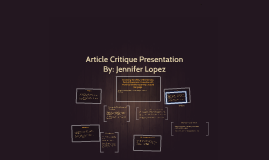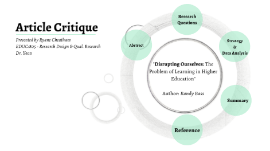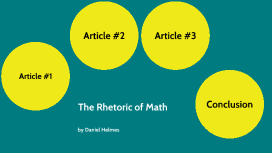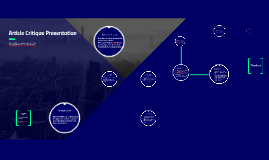Article Critique Presentation
Transcript: Erin M. Burns, MS, PhD, MSPH; Purushotham Guroji, MS, PhD; Israr Ahmad, MS, PhD; Hana M. Nasr, MPH; Yingxue Wang, MPH; Iman A. Tamimi, MD; Elijah Stiefel, MD; Mohammad S. Abdelgawwad, MD; Abdullah Shaheen, BS; Anum F. Muzaffar, BS; Lisa M. Bush, MS, GCC; Christina B. Hurst, MS, GCC; Russell L. Griffin, MPH, PhD; Craig A. Elmets, MD; Nabiha Yusuf, MS, PhD Daniel Cenicola Sam Scribner Lonaya Baker Mike Pietrowski Association of Vitamin D Receptor Polymorphisms With the Risk of Nonmelamona Skin Cancer in Adults Background & Literature Review •3.5 million new diagnoses of nonmelanoma skin cancer (NMSC) are reported each year. • NMSC is the 5th most costly cancer to treat in the Medicare population • Risk factors for increased risk include white, male, and sun exposure Background & Literature Review Key abbreviations: NMSC – Nonmelanoma Skin Cancer SCC – Squamous Cell Carcinoma BCC – Basal Cell Carcinoma SNP – Single Nucleotide Polymorphism Information provided by: https://surgery.ucsf.edu/conditions--procedures/nonmelanoma-skin-cancer.aspx • Previous studies examining certain polymorphisms and increased risk for NMSC have been contradictory. • This study will look at a population with high mean UV exposure, compared to other studies that looked at populations with moderate exposures. • Is there an association between vitamin D receptor single-nucleotide polymorphisms and the risk of NMSC? Background & Literature Review Contd. Key abbreviations: NMSC – Nonmelanoma Skin Cancer SCC – Squamous Cell Carcinoma BCC – Basal Cell Carcinoma SNP – Single Nucleotide Polymorphism Provided by: https://www.epa.gov/sunsafety/uv-index-1 Methods & Study Design Case control study 97 Cases (3 excluded due to poor sample quality) Received a diagnosis of and were being treated for BCC or SCC 29: non-Hispanic white women 68: non-Hispanic white men 100 Controls: receiving treatment of a condition other than skin cancer 54: non-Hispanic white women 46: non-Hispanic white men Recruitment site: The dermatology clinics at the Kirklin Clinic of the University of Alabama at Birmingham Hospital Time frame: Jan. 1, 2012 - Dec. 21, 2014 Methods & Study Design Provided by: www.uabmedicine.org Tools: Questionnaire — Collected information about skin, hair, eye color, family history of skin cancer, sun exposure history( tanning ability/severe sunburns experienced in life time) QIAamp DNA Blood Mini Kit Qiagen: blood sample collected (genotypes) Examined 3 known VDR (Vitamin D Receptor) polymorphisms: ApaI, BsmI & TaqI Methods & Study Design Contd. Provided by: https://www.labome.com/method/DNA-Extraction-and-Purification.html Results & Key Conclusions •After adjusting for age and sex, the following risk factors significantly increased odds of NMSC: •Light skin color (OR, 5.9 {95% CI, 1.31-5.10]) •Light eye color (OR, 2.47 [95% CI, 1.30-4.67]) •Lesser ability to tan (OR, 2.35 [(95% CI, 1.23 – 4.48]) •Risk factors of family history and hair color did not reach statistical significance in this study. Results & Key Conclusions Key abbreviations: NMSC – Nonmelanoma Skin Cancer SCC – Squamous Cell Carcinoma BCC – Basal Cell Carcinoma SNP – Single Nucleotide Polymorphism Significant risk factors identified specifically for men included: •Light skin color (OR, 4.10 [95% CI, 1.46-11.47]) •Lesser ability to tan (OR, 2.31 [95% CI, 0.87-6.12]) •Lighter eyes (OR, 3.26 [95% CI, 1.24 - 8.56]) Results & Key Conclusions Contd. Key abbreviations: NMSC – Nonmelanoma Skin Cancer SCC – Squamous Cell Carcinoma BCC – Basal Cell Carcinoma SNP – Single Nucleotide Polymorphism Significant risk factors identified specifically for women included: •Light skin color (OR, 8.43 [95% CI, 1.70-41.86]) •Greater number of severe sunburns (OR, 8.00 [95% CI, 2.01-31.84]) Results & Key Conclusions Contd. Key abbreviations: NMSC – Nonmelanoma Skin Cancer SCC – Squamous Cell Carcinoma BCC – Basal Cell Carcinoma SNP – Single Nucleotide Polymorphism In terms of the genotype distributions: •Only the ApaI SNP differed significantly between the cases and controls. •ApaI A allele was more frequent among controls than cases (0.500 vs. 0.405; P = .01) •BsmI b allele was significantly less frequent among controls than cases (0.360 vs. 0.464; P = .04) •TaqI allele was also less frequent among controls, but not significantly so (0.345 vs. 0.382; P=.09) Results & Key Conclusions Contd. Key abbreviations: NMSC – Nonmelanoma Skin Cancer SCC – Squamous Cell Carcinoma BCC – Basal Cell Carcinoma SNP – Single Nucleotide Polymorphism Strengths & Limitations Strengths •Performed separate analysis for men and women • Age-adjusted results •Use of case control study design: •ability to explore multiple exposures •NSMC has a long induction and latent period •Selecting hospital controls •Easily identifiable and accessible •More willing to participate than population-based controls Strengths & Limitations Limitations •Recall bias: allow participants to fill out baseline questionnaires -Some participants were unsure

















